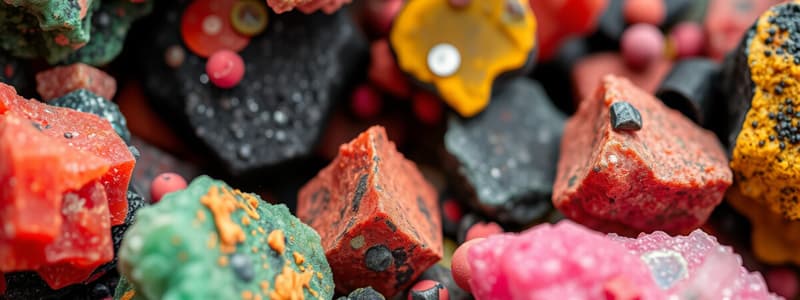Podcast
Questions and Answers
What relationship exists between mobility and crystallite size?
What relationship exists between mobility and crystallite size?
- Higher mobility leads to larger crystallite size. (correct)
- Larger crystallite size decreases mobility.
- Mobility has no effect on crystallite size.
- Higher mobility leads to smaller crystallite size.
How does increased mobility affect crystallite orientation?
How does increased mobility affect crystallite orientation?
- It results in random crystallite orientation.
- It improves the crystallite orientation. (correct)
- It has no impact on crystallite orientation.
- It worsens the crystallite orientation.
What can be inferred about mobility if the crystallite size is small?
What can be inferred about mobility if the crystallite size is small?
- Mobility fluctuates with temperature.
- Mobility must be low. (correct)
- Mobility is at its highest.
- Mobility is irrelevant to crystallite size.
What is the primary effect of enhanced mobility on crystallites?
What is the primary effect of enhanced mobility on crystallites?
Which statement best captures the importance of mobility in crystallite development?
Which statement best captures the importance of mobility in crystallite development?
What is one method used to activate charcoal?
What is one method used to activate charcoal?
At what temperature range is charcoal typically heated for activation?
At what temperature range is charcoal typically heated for activation?
Which chemical is NOT mentioned as a means to impregnate charcoal?
Which chemical is NOT mentioned as a means to impregnate charcoal?
What does GICs stand for in the context provided?
What does GICs stand for in the context provided?
Which material is associated with expanded graphite in the content?
Which material is associated with expanded graphite in the content?
What is the role of oxidizing gases in the charcoal activation process?
What is the role of oxidizing gases in the charcoal activation process?
What temperature range is specifically mentioned for impregnating charcoal with chemicals?
What temperature range is specifically mentioned for impregnating charcoal with chemicals?
What is the significance of the compounds mentioned in the content?
What is the significance of the compounds mentioned in the content?
Which property is likely attributed to expanded graphite?
Which property is likely attributed to expanded graphite?
What type of compound is primarily discussed in relation to GICs?
What type of compound is primarily discussed in relation to GICs?
What type of pores predominantly make up the structure of activated carbon?
What type of pores predominantly make up the structure of activated carbon?
Which activated carbon material has the narrowest distribution of pore sizes?
Which activated carbon material has the narrowest distribution of pore sizes?
What characteristics are prevalent among the activated carbon fibers mentioned?
What characteristics are prevalent among the activated carbon fibers mentioned?
In terms of pore sizes, what is a key feature of fibers compared to other activated carbons?
In terms of pore sizes, what is a key feature of fibers compared to other activated carbons?
Which property is NOT associated with fibers in activated carbon materials?
Which property is NOT associated with fibers in activated carbon materials?
What effect do coronary artery stents and heart valves have on platelets when they come into contact with blood?
What effect do coronary artery stents and heart valves have on platelets when they come into contact with blood?
What potential consequence is associated with the release of metallic ions from coronary artery stents and heart valves?
What potential consequence is associated with the release of metallic ions from coronary artery stents and heart valves?
Which of the following statements is true regarding the interaction of stents and valves with blood?
Which of the following statements is true regarding the interaction of stents and valves with blood?
What is one of the effects of coronary artery stents and heart valves on the blood environment?
What is one of the effects of coronary artery stents and heart valves on the blood environment?
In what manner do coronary artery stents and heart valves affect enzyme activity?
In what manner do coronary artery stents and heart valves affect enzyme activity?
Flashcards are hidden until you start studying
Study Notes
Crystallite Mobility and Size
- Higher mobility results in larger crystallite size and improved crystallite orientation.
- Important for the development of advanced materials, including oxide and graphite intercalated compounds (GICs).
Activation of Charcoal
- Charcoal activation is performed by heating it between 600–1200 °C in the presence of oxidizing gases like CO2, steam, or air.
- Alternative activation methods include chemical impregnation with acids (e.g., phosphoric acid), bases (e.g., potassium hydroxide), or salts (e.g., zinc chloride), followed by heating to 450–900 °C.
Micropores in Activated Carbon
- The structure of activated carbon (AC) primarily consists of micropores.
- Micropores play a critical role in the adsorptive properties of AC, enhancing its effectiveness in various applications.
Characteristics of Activated Carbon Fibers
- Among various activated carbon materials, fibers exhibit the narrowest distribution of pore sizes and are abundant in nanopores.
- These characteristics make activated carbon fibers particularly suitable for applications requiring specific adsorption properties.
Biomedical Applications
- Coronary artery stents and heart valves can activate platelets upon contact with blood.
- Release of metallic ions from these devices may result in enzyme inhibition, posing potential risks in medical applications.
Studying That Suits You
Use AI to generate personalized quizzes and flashcards to suit your learning preferences.




